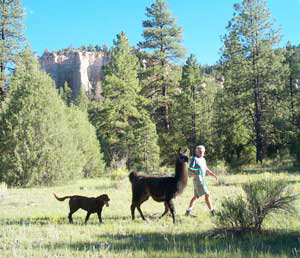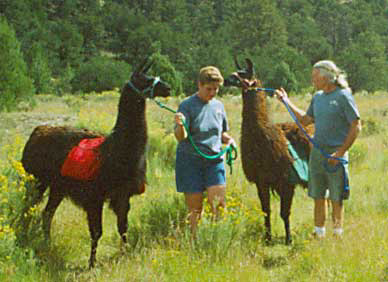|
Take a horse, stretch out his neck, replace his ears with bananas, cover him with thick woolly fur and slip on deer feet and what do you have? A large, fuzzy, friendly, non-ruminant (hoofed, cud-chewing mammal), domesticated animal called a llama (that does ruminate). These fascinating animals are from the camel family - technically called camelids.
So, what do these guys have to do with hiking? Believe it or not, llamas have been bred for pack animals since around 3000-4000 BC and are one of the best ways to haul all of your "stuff" into the great north-woods. They have two-toed feet with leathery pads for excellent traction and agility (causing minimal damage to the environment) and readily adapt to arid conditions (meaning they need very little water). Unlike ruminants' four-compartment stomachs, llamas have three compartment stomachs. This means it takes less feed for a llama than, for example, a sheep. Their large eyes can see for great distances, which makes them great guard animals. According to llamaweb.com, brown and black bears have been known to avoid camps where llamas reside. I am amazed llamas can carry one-third of their body weight and the average weight of a llama is 300-450 pounds. All that and they make great companions!

|

Terry and Dave Fillipi own a 40-acre llama and alpaca ranch in Nutrioso called "Waugh Mountain Alpacas." the Apache-Sitgreaves National Forest borders the ranch at the edge of the Escudilla Wilderness, making it prime hiking terrain.
Recently, Terry and Dave have decided to share their llamas with outdoor enthusiasts and are offering lunch and happy hour hikes with their furry friends. For more information contact Terry or Dave at 928-339-4244.
This article was originally published in "Take A Hike" magazine October 2003 issue.
|

